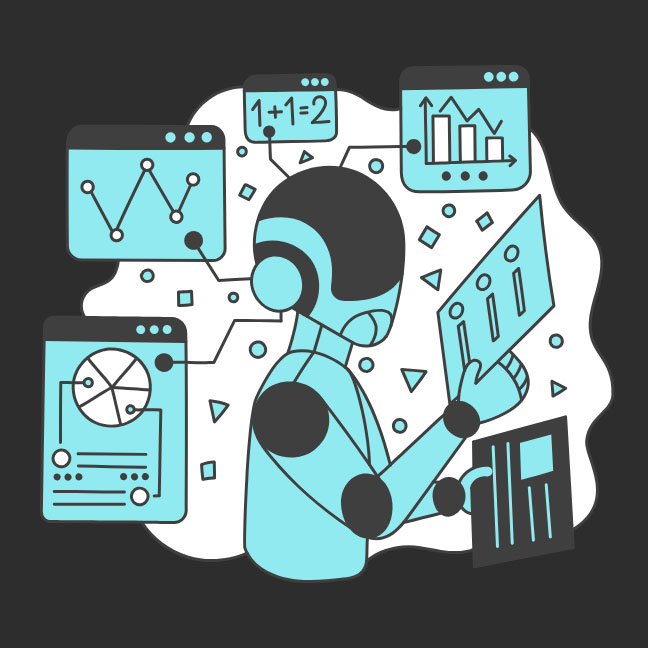Artificial Intelligence, zBlog
Different Types of AI Explained: A Complete Guide for 2026
trantorindia | Updated: July 22, 2025
Artificial Intelligence (AI) is no longer a futuristic concept. It is now an indispensable component of modern business strategy. From automating customer interactions to predicting market trends, AI is helping organizations achieve unprecedented efficiency, personalization, and scalability. This guide explores the different types of AI and how each type is transforming industries, enhancing operations, and delivering measurable value.
According to McKinsey, over 50% of companies have adopted AI in at least one business function, and this trend is expected to rise rapidly with the evolution of generative and agentic AI. Understanding the different types of AI helps businesses identify where to invest, which models to use, and how to align AI strategies with business goals.
1. AI by Capability: Narrow, General, and Super AI
1.1 Narrow AI (Weak AI)
Narrow AI is task-specific and designed to perform singular actions. These systems are trained on labeled datasets and operate within a restricted domain.
- Examples: Chatbots, facial recognition, recommendation systems
- Business Use Cases: Fraud detection, email classification, virtual assistants
- Narrow AI is the most commonly used type among the different types of AI in real-world applications.
1.2 General AI (AGI)
AGI refers to AI that can understand, learn, and apply intelligence across a wide range of tasks at a level comparable to a human being.
- Examples: Currently theoretical, explored by organizations like DeepMind and OpenAI
- Business Potential: Strategic decision-making, multi-domain automation
- Among the different types of AI, AGI remains the most ambitious and future-focused.
1.3 Super AI
Super AI is a concept where machines exceed human intelligence. While not yet realized, it raises important questions about safety, control, and ethics.
- Examples: None to date
- Business Considerations: Long-term regulatory foresight and philosophical debate
2. AI by Functionality: Reactive, Limited Memory, Theory of Mind, and Self-Aware
2.1 Reactive Machines
These AI systems respond to specific inputs with pre-programmed outputs but don’t learn or retain data.
- Example: IBM’s Deep Blue chess computer
- Use Cases: Manufacturing robotics, QA testing bots
- Reactive Machines represent the simplest among the different types of AI.
2.2 Limited Memory AI
This type can learn from historical data and make data-informed decisions.
- Example: Autonomous vehicles, predictive analytics platforms
- Use Cases: Chatbots, customer behavior modeling, loan underwriting
2.3 Theory of Mind AI
This conceptual AI would understand human emotions, beliefs, and intentions.
- Status: Under active research
- Use Cases: Adaptive customer support, emotion-aware systems
- As a subset of the different types of AI, Theory of Mind AI is still in the theoretical phase.
2.4 Self-Aware AI
Self-aware AI would possess consciousness. It exists only in theory and science fiction.
- Status: Not achieved
- Use Cases: Ethical frameworks, AI safety protocols
3. Emerging and Evolving AI Models in 2026
3.1 Generative AI
Generative AI models create content from prompts using large language models (LLMs) or generative adversarial networks (GANs).
- Examples: ChatGPT, Midjourney, DALL·E, Claude
- Use Cases: Content generation, marketing assets, automated design, product descriptions
- It’s one of the most impactful different types of AI for content and media industries.
3.2 Agentic AI
Agentic AI features autonomous agents that reason, plan, and act toward goals independently.
- Examples: LangChain + ReAct + AutoGPT
- Use Cases: Autonomous operations, workflow automation, enterprise optimization
- Agentic AI is a new frontier in the different types of AI aimed at achieving autonomy.
3.3 Blended AI (Hybrid Systems)
Blended AI combines machine learning with rule-based systems for enhanced decision-making.
- Examples: Ensemble learning, model stacking, logic-based filters
- Use Cases: Financial forecasting, personalized recommendations, medical diagnostics
3.4 Multimodal AI
Multimodal AI can process and analyze multiple types of input such as text, images, and speech.
- Examples: GPT-4V, Google Gemini, Meta’s ImageBind
- Use Cases: Visual search, digital twins, virtual assistants
4. Comparing Different Types of AI
The table below summarizes the different types of AI, showcasing their complexity, scope, and applications.
5. Industry-Specific Applications of Different Types of AI in 2026
In every industry, the different types of AI are unlocking new value streams:
Healthcare
- Diagnostic imaging (Blended AI)
- Medical records summarization (Generative AI)
- Patient interaction (Limited Memory AI)
Retail & eCommerce
- Personalized product feeds (Narrow AI)
- Conversational commerce (Generative + Agentic AI)
- Logistics optimization (Agentic AI)
Banking & Finance
- Credit risk modeling (Blended AI)
- Financial news summarization (Generative AI)
- Insider threat detection (Agentic AI)
Manufacturing
- Predictive maintenance (Limited Memory AI)
- Autonomous production (Agentic AI)
- Quality assurance (Reactive AI)
Media & Entertainment
- Script writing and editing (Generative AI)
- Personalized content recommendations (Narrow AI)
- Interactive storytelling (Multimodal AI)
EdTech & Learning
- Intelligent tutoring systems (Blended AI)
- Visual question answering (Multimodal AI)
- Adaptive curriculum (Limited Memory AI)
6. Trends and Future Outlook
The future of the different types of AI includes:
- Rise of Multimodal Models
- Agentic Coordination in Enterprises
- Federated and Edge AI Growth
- Human-Centric and Ethical Design
7. Challenges and Risks with Each Type of AI
Each of the different types of AI comes with its own set of risks. Understanding these is critical to responsible deployment.
8. FAQs: Quick Answers to Common Questions
Q: Why should businesses care about different types of AI?
A: Choosing the right type ensures proper alignment with business goals and risk tolerance.
Q: Are all types of AI used equally in practice?
A: No, Narrow AI and Limited Memory AI are the most widely adopted among the different types of AI.
9. Conclusion: How Trantor Helps You Harness the Power of AI
At Trantor, we help businesses integrate the different types of AI to solve real-world challenges. From rule-based systems to generative and agentic workflows, our solutions span:
- Custom LLM app development
- AI model integration and scaling
- Evaluation, governance, and monitoring pipelines
- Strategic consulting on AI maturity and implementation
We’ve enabled global enterprises to reduce cost, boost performance, and innovate faster using tailored AI strategies. Whether you’re exploring your first chatbot or orchestrating a fleet of multi-agent models, Trantor is your partner in enterprise AI success.
👉 Partner with Trantor to scale your business with intelligent, future-ready AI.



